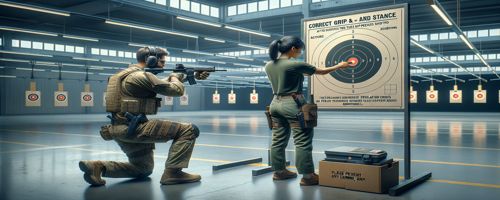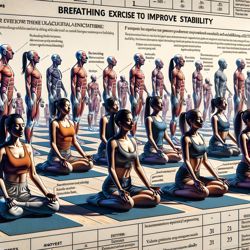Accuracy Assessment Criteria by SWAT DIGEST
In today’s world, issues of personal safety and professional training for law enforcement officers are becoming increasingly relevant. SWAT DIGEST — an authoritative resource dedicated to tactics and shooting — offers its own accuracy assessment system, based on years of experience of U.S. special units. Accuracy is not only about hitting the target but also about maintaining composure, making quick decisions, and effectively using weapons in different conditions.
SWAT DIGEST criteria include several key aspects:
- Shot accuracy: percentage of hits in the target zone at different distances.
- Reaction time: interval between detecting a threat and the first shot.
- Series consistency: spread of hits during bursts or series of shots.
- Adaptation to changing conditions: ability to shoot from different positions and at varying distances.
- Weapon safety: strict compliance with safety rules is mandatory.
These criteria make it possible to objectively assess shooting proficiency, identify weaknesses, and build an individual development program. According to SWAT DIGEST, only 17% of shooters consistently demonstrate high results in all criteria, which highlights the importance of a comprehensive approach to training.
The Role of Proper Grip and Stance

One of the basic elements of successful shooting is the correct grip technique and stance. As SWAT DIGEST instructors note, even minor mistakes in these aspects lead to a significant decrease in accuracy. The grip should be firm but not overly tense — excessive pressure causes hand tremors and reduces trigger control.
A proper stance provides body stability during recoil. The most effective isometric stance (artificial muscle tension) has the feet shoulder-width apart, knees slightly bent, and torso leaning forward. This position allows quick reactions to changing situations and minimizes shot dispersion.
According to SWAT DIGEST statistics, shooters with well-practiced grip and stance techniques show up to 35% less shot spread compared to beginners. To consolidate skills, regular practice of basic drills is recommended under the supervision of an experienced instructor or with video recording for self-analysis.
Breathing Exercises for Improved Stability

Breath control plays a critical role in ensuring shooting stability. Improper breathing causes involuntary body and hand movements, negatively affecting accuracy. SWAT DIGEST experts recommend using special breathing exercises to increase concentration and reduce stress levels.
One of the most effective methods is the “breathing pause” technique. It involves briefly holding the breath after a full inhale or exhale right before pulling the trigger. This temporarily stabilizes the body and minimizes micro-movements.
Recommended exercises:
- Deep diaphragmatic breathing: promotes muscle relaxation.
- Breathing pause of 2–3 seconds: improves trigger control.
- Alternating breathing rhythms during training: helps adapt to stressful situations.
According to research published in SWAT DIGEST in 2023, implementing breathing exercises increases shooting accuracy for 78% of practitioners after just one month of regular training.
Reaction and Aiming Speed Training
Modern tactical situations require not only high accuracy but also lightning-fast reaction. Aiming speed training significantly increases the chances of successfully hitting a target under time constraints. SWAT DIGEST offers a number of drills aimed at developing these skills.
One key drill is the “shooting drill with timer.” The shooter fires a series of shots upon a timer or light signal, aiming to minimize the time between detecting the target and the first shot. It is important to balance reaction speed with maintaining acceptable accuracy.
For increased effectiveness of training, it is recommended to:
- Use electronic timers (e.g., Shot Timer Pro).
- Gradually increase task difficulty (add moving targets or lighting changes).
- Analyze training videos to identify mistakes.
SWAT DIGEST practical data shows: shooters who regularly train with timers reduce their average reaction time by 0.4–0.7 seconds after just four weeks of practice.
Using Targets at Variable Distances
Training with targets at different distances develops shooter adaptability and the ability to quickly adjust to changing combat or self-defense conditions. Unlike static drills at fixed distances (usually 10–15 meters), variable distances require quick aiming adjustments and bullet trajectory calculations.
In SWAT DIGEST training, the following formats are widely used:
| Target type | Distance (yards) | Training goal |
|---|---|---|
| Standard paper | 5–25 | Accuracy practice |
| Reactive | 10–30 | Reaction speed |
| Silhouette | 7–50 | Tactical training |
| Miniature | 15–35 | Fine motor skills |
Variable distance drills teach shooters to estimate range by eye, choose the optimal angle of attack, and instantly adjust grip or stance for new conditions. This is especially important for police or military units, where situations can change every second.
SWAT DIGEST experts note: shooters who regularly practice variable distance shooting show higher tactical accuracy in real scenarios (+22% compared to average results).
Scenario-Based Shooting for Tactical Accuracy
Real situations are rarely predictable — that is why scenario-based shooting takes a special place in the training system. This is a set of drills simulating real combat episodes: hostage defense, countering attacks from cover, or operating in urban environments.
SWAT DIGEST methodology includes the following elements:
- Simulating enemy appearance from cover
- Unexpected target position changes
- Limited time for decision-making
- Additional stress factors (noise, light interference)
Scenario training helps not only improve shooting technique but also develop psychological resilience to stress. According to the 2022 report of the U.S. National Association of Police Officers, special unit officers regularly undergoing scenario training by SWAT DIGEST methods show better real-world performance (success rates rise to 91%).
Dry Fire: Ammo-Free Drills
Dry fire training means practicing shooting elements without using ammunition. This approach significantly reduces training costs (a .223 Remington round costs about $0.60 each) and at the same time improves basic movement mastery through more repetitions.
Key advantages of dry fire:
- Safety (no risk of accidental discharge)
- Ability to train at home or office
- Focus on technique details without recoil distraction
Popular dry fire drills:
- Practicing grip and weapon draw
- Aiming at various objects with sights
- Trigger control simulation
- Transitioning between targets while maintaining stability
SWAT DIGEST recommends including dry fire training in the daily routine — at least 10–15 minutes in the morning or evening to reinforce motor skills.
Error Analysis and Shooting Technique Correction
Even experienced shooters face mistakes — it is important to detect and correct them in time for further progress. SWAT DIGEST instructors advise keeping a detailed training log recording each session’s results: reaction time, hits/misses, error types.
Most common mistakes:
- Insufficiently firm grip
- Incorrect trigger finger placement
- Overstrained shoulder muscles
- Premature trigger jerking
Modern apps like MantisX Shooting Performance System ($149) can be used for analysis, tracking weapon micro-movements during shots via Bluetooth sensor.
Error correction should be systematic:
- Identify the most frequent misses.
- Analyze each error with an instructor or via video review.
- Include corrective drills in the training plan.
- Repeat analysis every two weeks to monitor progress.
This approach ensures steady skill development even for advanced shooters.
Recommendations on Training Frequency and Intensity
Effective accuracy development requires a systematic approach to training. According to SWAT DIGEST experts, the optimal schedule combines live fire practice, dry fire training, and theoretical sessions analyzing weapon tactics.
Recommended weekly program structure:
| Day | Training type | Duration |
|---|---|---|
| Monday | Dry fire | 20 minutes |
| Tuesday | Live fire | 60 minutes |
| Wednesday | Video/error analysis | 30 minutes |
| Thursday | Scenario drills | 45 minutes |
| Friday | Dry fire | 20 minutes |
| Saturday | Variable distances | 60 minutes |
| Sunday | Rest / Theory | - |
For steady progress, it is important to maintain moderate intensity without overstraining wrist/forearm muscles; stretching after each block is recommended to prevent tendon injuries.
SWAT DIGEST emphasizes the importance of consistency: even short daily sessions are more effective than occasional long ones once a month (+27% accuracy improvement in systematic shooters).
Invest your time wisely in organizing your training — it’s the key to confidence both at the shooting range and in extreme situations!